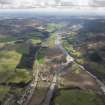Ballinluig Viaduct
Railway Viaduct (19th Century)
Site Name Ballinluig Viaduct
Classification Railway Viaduct (19th Century)
Alternative Name(s) River Tummel; Ballinluig Railway Bridge; Ballinluig, Tummel Road Bridge
Canmore ID 26322
Site Number NN95SE 18
NGR NN 9761 5208
Datum OSGB36 - NGR
Permalink http://canmore.org.uk/site/26322
- Council Perth And Kinross
- Parish Logierait
- Former Region Tayside
- Former District Perth And Kinross
- Former County Perthshire
NN95SE 18 9761 5208
Not to be confused with railway viaduct over the River Tay at Logierait (NN 9686 5180), for which see NN95SE 23.
(Location cited as NN 977 521). Railway bridge over Tummel, Ballinluig, opened 1865 by the Highland Rly, engineer Joseph Mitchell. Two parallel iron-truss main spans, with short plate-girder approaches, now used as a road bridge.
J R Hume 1977.
This viaduct was designed by Joseph Mitchell to carry the [Aberfeldy branch of the] Inverness and Perth Junction Rly across the River Tummel and opened on 9 September 1863 at a cost of ?11,156; it remains in use. It is of lattice girder type on cast iron piers and measures 351 ft (107m) in overall length and 36 ft (11m) in height; it comprises two spans of 122 ft (37.2m) and another two of 35 ft (10.7m). The cylindrical piers measure 8 ft (2.4m) in diameter and are weighed down with masonry rubble filled with Portland cement, the additional side spans being added as a protection against damage from floodwater.
M Smith 1994.
This viaduct now carries the (Ballinluig - Aberfeldy) A 827 public road across the River Tummel, access from the reconstructed A9 trunk road being gained by an approach on a rising curve through Ballinluig village.
Information from RCAHMS (RJCM), 14 June 1996.
Construction (1863)
Provided with sets of iron towers reminiscent of locomotive funnels.
R Paxton and J Shipway 2007






























